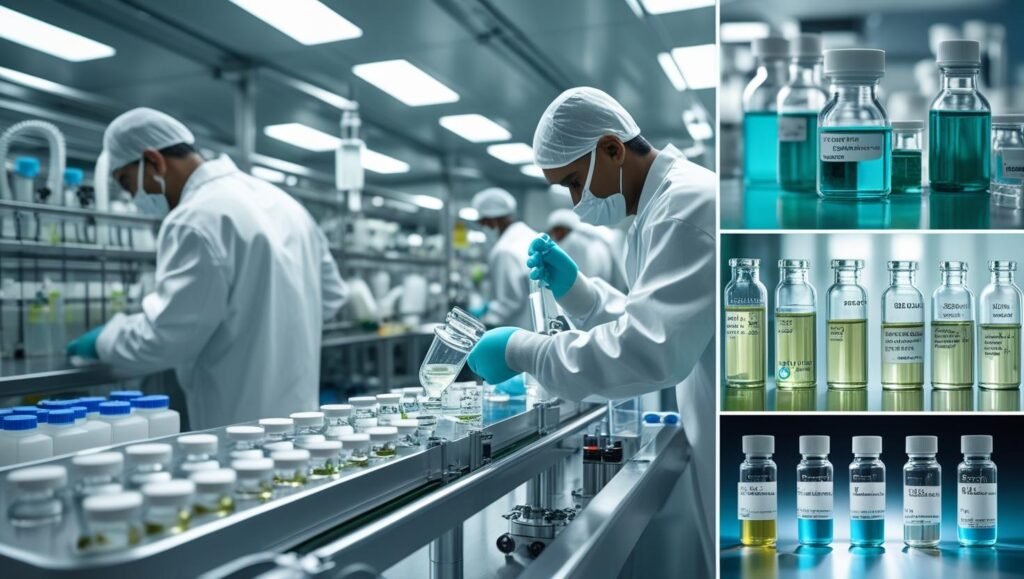
India’s peptide API market is experiencing seismic shifts as global demand for GLP-1 agonists like semaglutide and tirzepatide skyrockets toward a projected $150 billion by 2030. With semaglutide’s Indian patent expiration in March 2026 triggering a gold rush among domestic pharma giants, the country’s peptide CDMO sector—currently a $80 million segment—is poised for 14% CAGR growth. Yet beneath this boom lies a high-stakes balancing act: Can Indian manufacturers scale production while maintaining international quality standards amid supply chain fragmentation and regulatory bottlenecks? This analysis uncovers the strategic realignments defining India’s peptide revolution and the trade-offs that could make or break its global ambitions.
The Supply Chain Transformation: From Import Dependence to Peptide Powerhouse
India’s peptide ecosystem is undergoing three fundamental shifts:
1. Geopolitical Reshoring Accelerated by PLI Schemes
Post-COVID vulnerability exposed India’s 70% dependence on Chinese API imports. The Production Linked Incentive (PLI) scheme’s ₹6,940 crore ($850M) outlay is actively rewriting this narrative:
- 35 new greenfield manufacturing facilities sanctioned across Gujarat, Maharashtra, and Andhra Pradesh.
- Domestic production of 38 critical APIs like Atorvastatin and Metformin initiated since 2023.
- 50% import reduction achieved for high-demand peptides, targeting 75% by 2027.
Dr. Reddy’s $150M Vizag expansion exemplifies this shift, focusing on oncology and cardiovascular peptides.
2. CDMO Capability Leapfrogging
Indian CDMOs are moving beyond basic synthesis to integrated service ecosystems:
| Company | Capability Advancement | Market Impact |
|---|---|---|
| Syngene International | Validated LC-MS/MS methods for semaglutide bioequivalence trials | Solving autosampler carryover & low-detection limits. |
| Anthem Biosciences | Biosynthetic peptide production (rare in India) | Positioning for complex GLP-1 analogs. |
| USV Peptides | End-to-end solutions from non-GMP to multi-kg GMP | CMC and DMF support for global filings. |
3. Therapeutic Demand Surge
Domestic health crises are driving peptide innovation:
- Diabetes: 77 million patients escalating to 134M by 2045.
- Obesity: 11% adult prevalence creating sarcopenia epidemic.
- Market Response: Caregen’s muscle-building peptide “MyoKi” registered in India after clinical trials showed 2.56% lean mass increase.
“The semaglutide patent cliff isn’t just a generic opportunity—it’s India’s chance to prove its peptide infrastructure can outperform China on quality, not just cost.” — Nilaya Varma, CEO of Primus Partners.
The Quality Compliance Tightrope: Where India Stumbles
Despite progress, three fault lines threaten India’s peptide ambitions:
1. Infrastructure Deficits
BIS-accredited labs face critical shortages:
- Outdated equipment in 60% of government testing facilities.
- 2-6 month delays for peptide certification due to staffing gaps.
- Rejection of international certifications forcing duplicate testing.
Result: US manufacturers report “$10M+ compliance costs” for Indian market entry.
2. Regulatory Fragmentation
BIS’s labyrinthine processes create bottlenecks:
- No timeline for foreign facility certifications under FMCS.
- Mandatory domestic retesting despite global GMP documentation.
- QCO enforcement inconsistencies across 600 product categories.
3. Workforce Skill Gaps
Peptide synthesis requires specialized expertise where India lags:
- Only 15% of chemistry graduates trained in advanced purification techniques.
- High turnover at CDMOs disrupting batch consistency.
Zydus Lifesciences’ 2024 FDA observations highlight these vulnerabilities.
Strategic Trade-offs: How Leaders Are Balancing Scale and Quality
Forward-thinking players adopt calibrated approaches:
Technology Investments vs. Cost Control
- Syngene: Deploying blockchain-validated HPLC data to preempt FDA audits.
- Laurus Labs: Spending ₹5,000 crore on green chemistry peptide facilities.
- Trade-off: 20-30% higher capex versus Chinese competitors.
Operational Compromises
| Priority Area | Quality-Centric Approach | Cost-Centric Approach |
|---|---|---|
| Purification | Multi-step HPLC + mass spectrometry (>99.5% purity) | Single-pass HPLC (98-99% purity) |
| Starting Materials | ISO-certified Fmoc-amino acids (≤0.1% impurities) | Non-certified suppliers (cost savings: 40%) |
| Environmental Controls | Continuous cold chain monitoring (±0.5°C) | Passive cooling during logistics |
Regulatory Arbitrage
Top CDMOs exploit regulatory asymmetries:
- US/EU Markets: Full GMP with DMF filings and FDA pre-audits.
- Africa/SE Asia: WHO prequalification standards with 30% lower compliance costs.
- Domestic Indian Market: BIS minimum standards for price-sensitive segments.
The Roadmap: Bridging the Quality Chasm
Winning strategies for sustainable growth:
1. Cluster-Based Manufacturing
Bulk drug parks in Himachal Pradesh and Tamil Nadu consolidate resources:
- Shared wastewater treatment plants cutting EHS costs by 25%.
- Centralized testing hubs with automated LC/MS systems.
2. Regulatory Modernization
- Adopt Common Criteria Recognition Arrangement (CCRA) to accept global certifications.
- Digitalize BIS approvals using AI for document review (cut processing from 180→45 days).
3. Workforce Upscaling
Industry-academia initiatives like:
- Peptide Synthesis Excellence Centers at IITs with Anthem Biosciences.
- USV Peptides’ in-house GMP certification programs.
FAQs: Critical Questions for Peptide Sourcing Managers
Q: Can Indian CDMOs reliably supply GLP-1 APIs meeting EMA/FDA standards?
A: Top 5 players (Syngene, Divi’s, etc.) consistently pass audits, but mid-tier suppliers show 23% recall risk due to solvent residues. Third-party testing is non-negotiable for critical applications.
Q: How are tariffs impacting peptide sourcing costs?
A: US chemical import tariffs add 15-20% to Indian peptides, negating 30% of India’s cost advantage over China. Smart shippers use ASEAN FTA routes for tariff optimization.
Q: What’s the minimum quality verification for Indian peptides?
A: Mandatory checks should include:
- Batch-specific COA with mass spec purity >98.5%.
- Residual solvent analysis (DMF ≤ 880ppm).
- Forced degradation studies for oxidation hotspots.
Core Takeaways
- Supply Chain Realignment Is Accelerating: PLI schemes cut API imports by 50%, but material bottlenecks persist for protected amino acids.
- Two-Tier Quality Ecosystem Emerging: Leaders match global standards (USV, Syngene), while others struggle with BIS basics.
- Strategic Trade-offs Required: 99% purity costs 30% more than 98%—allocate quality spend by market requirements.
- Regulatory Innovation Critical: CCRA adoption and digital BIS could cut compliance timelines from 6→2 months.
Conclusion: The Inflection Point
India’s peptide boom represents more than economic opportunity—it’s a stress test for the nation’s pharmaceutical maturity. As Dr. Reddy’s scales its Visakhapatnam facility and Anthem Biosciences masters biosynthetic routes, they’re proving India can compete on sophistication, not just scale. Yet the Zydus FDA observations and BIS lab deficits reveal systemic frailties that could cap growth at 10% CAGR instead of the projected 14%. The winners will be those who treat quality not as a compliance cost, but as a competitive moat—embedding blockchain data trails, adopting green chemistry, and lobbying for regulatory modernization. For global buyers, this calculus is simple: partner with India’s top-tier CDMOs now, audit ruthlessly, and reap the dual advantage of 30% cost savings and future-proofed supply chains. The peptide gold rush is here—but only the vigilant will strike sustainable gains.
Disclaimer:
This article contains information, data, and references that have been sourced from various publicly available resources on the internet. The purpose of this article is to provide educational and informational content. All trademarks, registered trademarks, product names, company names, or logos mentioned within this article are the property of their respective owners. The use of these names and logos is for identification purposes only and does not imply any endorsement or affiliation with the original holders of such marks. The author and publisher have made every effort to ensure the accuracy and reliability of the information provided. However, no warranty or guarantee is given that the information is correct, complete, or up-to-date. The views expressed in this article are those of the author and do not necessarily reflect the views of any third-party sources cited.





